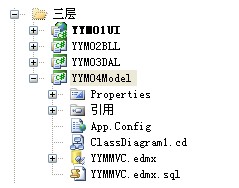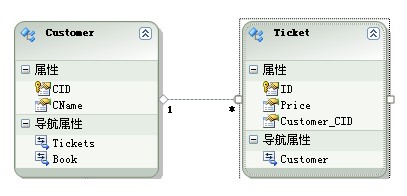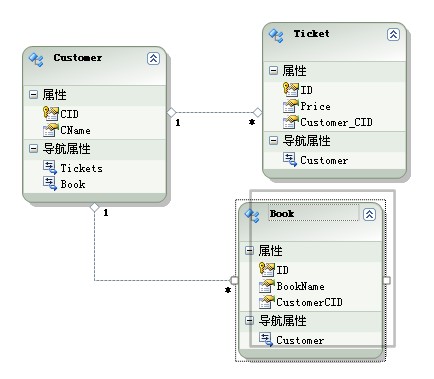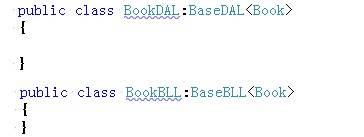
·您现在的位置: 云翼网络 >> 文章中心 >> 网站建设 >> 网站建设开发 >> ASP.NET网站开发 >> EF结合三层:三层中数据层父类和业务层父类的使用
- C#操作XML的完整例子——XmlDocument篇
- asp.net管理mysql数据库的小工具
- 使用ICallbackEventHandler接口实现轻量级的Ajax效果
- ASP.NETAJAX应用
- C# 导出word文档及批量导出word文档(4)
- 关于用ASP.Net识别远程主机服务器种类
- asp.net备份和恢复数据库
- VS2010在64位系统中连接64位Oracle出现的问题和解决方法
- wkhtmtopdf--高分辨率HTML转PDF(三)
- Linux.NET实战手记—自己动手改泥鳅(下)
- Unity IOC注入详细配置(MVC,WebApi)
- ASP.Net中数据展示控件的嵌套使用
- ASP.NET实现自适应图片大小的弹出窗口(窗口可任意编辑)
- Asp.Net函数集
- C#微信公众号接口开发,灵活利用网页授权、带参数二维码、模板消息,提升用户体验之完成用户绑定个人微信及验证码获取
- 【ASP.NET 进阶】Flv视频文件在线播放示例
- 基于WebForm+EasyUI的业务管理系统形成之旅 -- 首页快捷方式(Ⅲ)
- C#基础----Linq之List<T>篇
- 第一篇博客-MVC路由简述
- ASP.NET系统用户权限设计与实现
- 使用FindControl(id)查找控件 返回值都是Null的问题
- ASP.NET讲座(2)-ASP.NET控件
- Web应用程序项目XXXX已配置为使用IIS。无法访问IIS元数据库。您没有足够的特权访问计算机上的IIS网站
- ASP.NET 2.0服务器控件开发精要
- 最佳实践 ADO.NET实用经验无保留曝光
- ASP.NET数据库编程之处理文件访问许可
- 代替Reflection(反射)的一些方法
- 通过改善架构来提高 ASP.Net 应用程序的性能
- asp.net(vb.net)连接sql server 2000数据库的连接模块(module)
- 数据岛出到Excel最为简易的方法
EF结合三层:三层中数据层父类和业务层父类的使用
EF结合三层:三层中数据层父类和业务层父类的使用
今天我们主要讨论下数据层父类和业务层父类的使用。众所周知,数据层无非就是实现增删改查的方法。无论是哪个实体类,无非就是为了实现增删改查方法,所有我们在三层的DAL层封装了一个BaseDAL类,来做增删改查。在BLL层封装了一个BaseBLL类,来做增删改查。如果在Model层,通过ModelFirst的方式,又添加了新的实体(YYY),那么在DAL层只需要定义一个类YYYDAL,并让YYYDAL继承自BaseDAL即可。同理,在BLL层,只需要定义一个类YYYBLL,并让其继承自BaseBLL即可。下面我们来完成这个描述。
由于该文章的侧重点数据层父类和业务层父类的使用。所以我们就不再领着大家搭建三层结构。默认大家已经创建好的程序的架构。

并且在edmx模型中我们已经创建了两个实体。这里我们使用Customer和Ticket(由于最近在讲解影院售票系统)

步骤一:先在DAL层创建一个CustomerDAL类,并且书写对应的增删改查以及分页的方法。
1 public class CustomerDAL 2 { 3 //数据库上下文对象 4 YYMMVCEntities db = new YYMMVCEntities(); 5 /// <summary> 6 /// 新增操作 7 /// </summary> 8 public int Add(Customer customer) 9 {10 db.Customers.AddObject(customer);11 //保存成功后会将自增的ID设置成customer的主键属性12 return db.SaveChanges();13 } 14 //删除15 public int DeleteBy(int cid)16 {17 Customer customer=new Customer(){CID = cid};18 db.Customers.Attach(customer);19 db.Customers.DeleteObject(customer);20 return db.SaveChanges();21 }22 //根据条件删除23 public int DeleteExPRession(System.Linq.Expressions.Expression<Func<Customer,bool>> deleWhere)24 {25 List<Customer> customers=db.Customers.Where(deleWhere).ToList();26 customers.ForEach(m=>db.Customers.DeleteObject(m));27 return db.SaveChanges();28 }29 30 //修改方法31 public int Modify(Customer customer)32 {33 db.Attach(customer);34 db.ObjectStateManager.ChangeObjectState(customer, EntityState.Modified);35 return db.SaveChanges();36 }37 //查询38 publicList<Customer> GetListBy(System.Linq.Expressions.Expression<Func<Customer,bool>> seleWhere)39 {40 return db.Customers.Where(seleWhere).ToList();41 }42 //查询和排序43 public List<Customer> GetListBy<Tkey>(System.Linq.Expressions.Expression<Func<Customer,bool>> seleWhere,System.Linq.Expressions.Expression<Func<Customer,Tkey>> orderWhere)44 {45 return db.Customers.Where(seleWhere).OrderBy(orderWhere).ToList();46 }47 //分页查询48 public List<Customer> GetListPaged(int pageIndex,int pageSize,System.Linq.Expressions.Expression<Func<Customer,bool>> orderbyWhere)49 {50 return db.Customers.OrderBy(orderbyWhere).Skip((pageIndex - 1)*pageSize).Take(pageSize).ToList();51 } 52 }第二步:书写BaseDAL类
然后我们在DAL层新建一个BaseDAL类,类中内容是通过CustomerDAL修改而来的,将出现Customer的地方替换成了T,出现Customers的地方改成了CreateObjectSet<T>()
,修正后的类如下
1 public class BaseDAL<T> where T:class,new() 2 { 3 //数据库上下文对象 4 YYMMVCEntities db = new YYMMVCEntities(); 5 /// <summary> 6 /// 新增操作 7 /// </summary> 8 public int Add(T customer) 9 {10 //必须限定T的类型,只能为引用类型11 db.CreateObjectSet<T>().AddObject(customer);12 //保存成功后会将自增的ID设置成customer的主键属性13 return db.SaveChanges();14 }15 16 //删除17 public int DeleteBy(T model)18 {19 20 db.CreateObjectSet<T>().Attach(model);21 db.CreateObjectSet<T>().DeleteObject(model);22 return db.SaveChanges();23 }24 //根据条件删除25 public int DeleteExpression(System.Linq.Expressions.Expression<Func<T, bool>> deleWhere)26 {27 List<T> customers = db.CreateObjectSet<T>().Where(deleWhere).ToList();28 customers.ForEach(m => db.CreateObjectSet<T>().DeleteObject(m));29 return db.SaveChanges();30 }31 32 //修改方法33 public int Modify(T customer)34 {35 db.CreateObjectSet<T>().Attach(customer);36 db.ObjectStateManager.ChangeObjectState(customer, EntityState.Modified);37 return db.SaveChanges();38 }39 40 //查询41 public List<T> GetListBy(System.Linq.Expressions.Expression<Func<T, bool>> seleWhere)42 {43 return db.CreateObjectSet<T>().Where(seleWhere).ToList();44 }45 //查询和排序46 public List<T> GetListBy<Tkey>(System.Linq.Expressions.Expression<Func<T, bool>> seleWhere, System.Linq.Expressions.Expression<Func<T, Tkey>> orderWhere)47 {48 return db.CreateObjectSet<T>().Where(seleWhere).OrderBy(orderWhere).ToList();49 }50 //分页查询51 public List<T> GetListPaged(int pageIndex, int pageSize, System.Linq.Expressions.Expression<Func<T, bool>> orderbyWhere)52 {53 return db.CreateObjectSet<T>().OrderBy(orderbyWhere).Skip((pageIndex - 1) * pageSize).Take(pageSize).ToList();54 55 } 56 }其中publicclassBaseDAL<T>whereT:class,new()中whereT:class代表T的类型只能是引用类型,new()代表T类型必须有无参的构造。
到这里我们已经完成了对DAL层父类的书写。
第三步:书写BaseBLL类
接下来,我们就可以书写BaseBLL类了,当然,抽取BaseBLL类的方式和抽取BaseDAL的方式基本一致,在这里就直接写出BaseBLL的类的代码结构了。
1 public class BaseBLL<T> where T:class,new () 2 { 3 protected BaseDAL<T> dal = new BaseDAL<T>(); 4 /// <summary> 5 /// 新增操作 6 /// </summary> 7 public int Add(T customer) 8 { 9 return dal.Add(customer);10 }11 12 //删除13 public int DeleteBy(T cid)14 {15 return dal.DeleteBy(cid);16 }17 //根据条件删除18 public int DeleteExpression(System.Linq.Expressions.Expression<Func<T, bool>> deleWhere)19 {20 return dal.DeleteExpression(deleWhere);21 }22 23 //修改方法24 public int Modify(T customer)25 {26 return dal.Modify(customer);27 }28 29 //查询30 public List<T> GetListBy(System.Linq.Expressions.Expression<Func<T, bool>> seleWhere)31 {32 return dal.GetListBy(seleWhere);33 }34 //查询和排序35 public List<T> GetListBy<Tkey>(System.Linq.Expressions.Expression<Func<T, bool>> seleWhere, System.Linq.Expressions.Expression<Func<T, Tkey>> orderWhere)36 {37 return dal.GetListBy(seleWhere, orderWhere);38 }39 //分页查询40 public List<T> GetListPaged(int pageIndex, int pageSize, System.Linq.Expressions.Expression<Func<T, bool>> orderbyWhere)41 {42 return dal.GetListPaged(pageIndex, pageSize, orderbyWhere);43 44 } 45 }其实,我们发现一个问题,就先现在我们的BLL层就是起到了一个数据隔离的作用。
然后我们就可以在对应的DAL层和BLL层创建对应的子类来继承自各自的父类。接下来我们通过ModelFirst的方式修改edmx模型,在其中添加一个新的实体Book,并且建立Customer和Book之间的关系(1对多)。如下图:

步骤四:在DAL层添加BookDAL类,并且继承自BaseDAL;在BLL层添加BookBLL类,并且继承自BaseBLL类。

在页面的Load事件中书写如下代码:
1 if (!IsPostBack)2 {3 BookBLL bll=new BookBLL();4 List<Book> list=bll.GetListBy(m => m.ID > 0);5 Repeater1.DataSource = list;6 Repeater1.DataBind();7 }就可以验证子类对象是否成功继承父类的方法。

好的,我们今天的探讨到此结束!
- 上一篇文章: 函数返回一个SqlDataReader对象
- 下一篇文章: MVC 开启gzip压缩
- 在ASP.NET Atlas中调用Web Service——创建
- c#datetime格式化
- 发布一个自己写的PrintPreviewControl自定义
- 逆天通用水印支持Winform,WPF,Web,WP,W
- 提高效率!15款最好的Bug跟踪应用程序
- 初识 Asp.Net内置对象之Application对象
- ASP.NET的用户控件